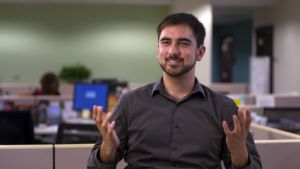
DeafTEC, Technological Education Center for Deaf and Hard-of-Hearing Students at the Rochester Institute of Technology, received a 2013 Telly Award for its video Deaf Professionals in IT: Mobile App Programmer. It is one of the compelling new videos about STEM technicians with hearing loss on the center's website.
The video was created by Pellet Productions of Reading, Massachusetts. Pellet Productions has produced several other ATE-related videos including ATE Central's ATE Student Success Stories.
The award-winning DeafTEC video features Matt Martella explaining the work he does as a mobile applications programmer at Highmark Inc., a health insurance company in Pittsburgh, Pennsylvania.
Telly Awards recognize the best film and video productions, groundbreaking online video content, and outstanding local, regional, and cable TV commercials and programs. The 34th Annual Telly Awards received more than 12,000 entries, which do not compete against each other. The judges for the 34th Annual Telly Awards used a performance scale to evaluate the creativity of the entries for silver and bronze awards. DeafTEC's video won a bronze award.
Donna Lange, DeafTEC principal investigator, appreciates the honor of the national recognition that came with a "very cute statue."
More than the award, Lange is excited about the well-produced videos that are dispelling myths about deaf and hard-of-hearing individuals. She hopes the videos will reach wider audiences with the center's message that deaf and hard-of-hearing individuals are capable STEM technicians.
A new engineering-manufacturing video features Ryan Shields, who operates a CNC machine to make jewelry at Tiffany & Co. The video shows Shields interacting with co-workers, calibrating equipment, and explaining the importance of his college degree. The National Technical Institute for the Deaf (NTID), one of nine RIT colleges in Rochester, New York, awards technical associate degrees that transfer to four-year programs. NTID enrolls approximately 1,300 deaf and hard-of-hearing students annually.
NTID faculty members administer DeafTEC, which became an ATE national center in 2011. DeafTEC had previously received ATE project grants for the Deaf Initiative in Information Technology, a faculty professional development program, and Project Fast Forward, a STEM dual credit program that currently has 21 partner high schools in 10 states.
Another of the recent additions to DeafTEC's online clearinghouse of resources for educators and employers are 40 math modules featuring Gary Blatto-Vallee, an NTID math and science instructor. While the modules are totally accessible to deaf and hard-of-hearing students they provide excellent guidance for instructors to teach basic math skills to all students.
Lange said Blatto-Vallee modeled his modules on Khan Academy lessons for mass audiences, but that he has utilized a more accessible, useful pedagogy for DeafTEC's math modules. The videos show Blatto-Vallee using American Sign Language as he teaches, pausing to allow viewers to read captions, and then solving problems as a voice-over explains to instructors the various teaching methodologies he employs.
"Our plans are to have e-learning training modules on the website for employers," Lange said. The employer modules will dispel myths about the perceived limitations of deaf employees, and offer effective strategies for communication and accommodation.
DeafTEC's train-the-trainer workshops at NTID provide the instruction that educators and employers need to teach their colleagues about interacting with deaf and hard-of-hearing students and co-workers. In 2012-13, the 26 high school and community college educators who attended Project Access training presented workshops to 300 educators in three states. In the same academic year, 12 industry representatives trained in Working Together presented information to 60 other business people about the benefits of working with deaf and hard-of-hearing individuals.

 Subscribe
Subscribe


 See More ATE Impacts
See More ATE Impacts

Comments
There are no comments yet for this entry. Please Log In to post one.